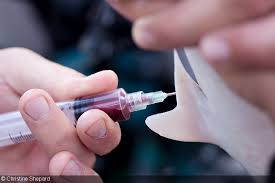When a shark is caught, it undergoes two different types of stress. The stress of exercising and running out the line prior to being in the boat and also the stress of being handled. Sharks lack several mechanisms in recovery from exercise that other fish have, ultimately leading to a full recovery window being 12 hours after the activity (Brill, 2008). Brill (2008) noted that in the blood samples taken, the exercised sharks had significantly higher blood lactate levels, hematocrit, hemoglobin, red cell volume, and plasma protein concentrations than the sharks unstressed. Sharks often react to the stress of being caught very erratically; often becoming hyperactive and violently thrashing around, which can increase the handling time of these predators (Hoffmayer, 2001). The majority of the studies done on wild sharks involve a blood sample to monitor stress levels. One study aimed to gain insight into physiological changes underwent by sharks in the wild. Hoffmayer (2001) completed a 60-minute stress period on Atlantic Sharpnose shark, and analyzed blood samples taken. Hoffmayer (2001) found significant differences in a few blood parameters that show stress. Significant levels of change in one parameter were noticed within 15 minutes of being captured; the same response has been noted in other sharks as well. As the levels increase, they could lead to the release of stress hormones which help the rapid release of glucose to the muscles during stress events. As the sharks were captured, their energy needs increased, which with a significant amount of lactate would show that the sharks then went into an oxygen debt (Hoffmayer, 2001). If a high lactate level was consistent throughout, it would be likely that a decline in blood pH would be prevalent. These changes would have other impacts on overall shark fitness. Sharks undergo acute stress from being caught and released. This stress is evident in many blood parameter changes. These stressors may affect fitness in some ways. However, it was noted that the catch and release of the sharks did not affect individual chance of mortality (Brill, 2008).
This image shows a person handling a shark (releasing back, after sampling). The image was taken from an underwater photography website called Divephotoguide. The picture itself was taken by Christine Shepard.
This image was also taken by Christine Shepard from the same website as the other image, it shows a research assistant taking a blood sample from a shark.
Sources:
http://www.divephotoguide.com/underwater-photography-techniques/article/guide-conservation-research-photography/
Hoffmayer, E.R., and G.R. Parsons. 2001. The physiological response to capture and handling stress in the Atlantic sharpnose shark, Rhizoprionodon terraenovae. Fish Physiology and Biochemistry, 25(4), pp.277-285.
Brill, R., P. Bushnell, S. Schroff, R. Seifert, and M. Galvin, 2008. Effects of anaerobic exercise accompanying catch-and-release fishing on blood-oxygen affinity of the sandbar shark (Carcharhinus plumbeus, Nardo). Journal of Experimental Marine Biology and Ecology, 354(1), pp.132-143.

